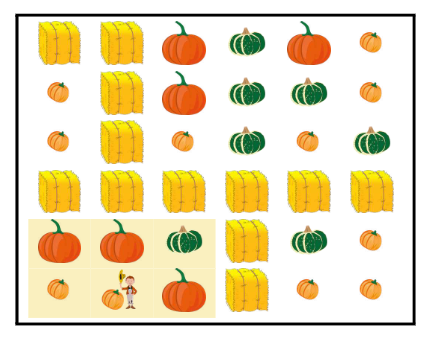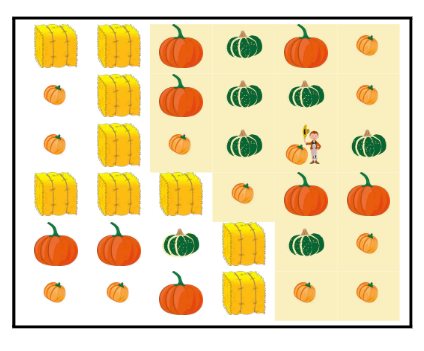CCC '24 J5 - Harvest Waterloo
View as PDFCanadian Computing Competition: 2024 Stage 1, Junior #5
There is a wildly popular new harvest simulation game called Harvest Waterloo. The game is played on a rectangular pumpkin patch which contains bales of hay and pumpkins of different sizes. To begin the game, a farmer is placed at the location of a pumpkin.
The farmer harvests all pumpkins they can reach by moving left, right, up, and down throughout the patch. The farmer cannot move diagonally. The farmer can also not move through a bale of hay nor move outside of the patch.
Your job is to determine the total value of all the pumpkins harvested by the farmer. A small pumpkin is worth , a medium pumpkin is worth
, and a large pumpkin is worth
dollars.
Input Specification
The first line of input is an integer which is the number of rows within the patch.
The second line of input is an integer which is the number of columns within the
patch.
The next lines describe the patch. Each line will contain
characters and each character will either represent a pumpkin size or a bale of hay:
S for a small pumpkin, M for a medium pumpkin, L for a large pumpkin, or * for a bale of hay.
The next line of input is an integer where
, and the last line of input is an integer
where
. Row
and column
is the starting location of the farmer and the top-left corner of the patch is row
and column
.
The following table shows how the available 15 marks are distributed:
| Marks | Description | Bound |
|---|---|---|
| 1 | The patch is small and there are no bales of hay. | |
| 4 | The patch is small and the bales of hay divide the entire patch into rectangular areas. | |
| 5 | The patch is small and the bales of hay can be anywhere. | |
| 5 | The patch is large and the bales of hay can be anywhere. |
Output Specification
Output the integer, , which is the total value in dollars of all the pumpkins harvested by the farmer.
Sample Input 1
6
6
**LMLS
S*LMMS
S*SMSM
******
LLM*MS
SSL*SS
5
1Output for Sample Input 1
37Explanation of Output for Sample Input 1

Starting at row and column
, the farmer can reach the
pumpkins in the highlighted area. They harvest
small pumpkins,
medium pumpkin, and
large pumpkins. The total value in dollars of this harvest is
.
Sample Input 2
6
6
**LMLS
S*LMMS
S*SMSM
***SLL
LLM*MS
SSL*SS
2
4Output for Sample Input 2
88Explanation of Output for Sample Input 2

Starting at row and column
, the farmer can reach the
pumpkins in the highlighted area. They harvest
small pumpkins,
medium pumpkin, and
large pumpkins. The total value in dollars of this harvest is
.
Comments
remember if ur using python to not forget about sys.setrecursionlimit(x) you will get IR error if u dont
or use bfs
how big do you have to set it
set it to 10^5 because the worst case is no haybales and r*c = 100000, in which case does 10^5 recursions. (note: maybe set it to 10^5 + 3 to prevent RecursionError because it works for me)
just set it to a gigantic number till it doesn't give one. sys.setrecursionlimit(10^7)
happy early birthday